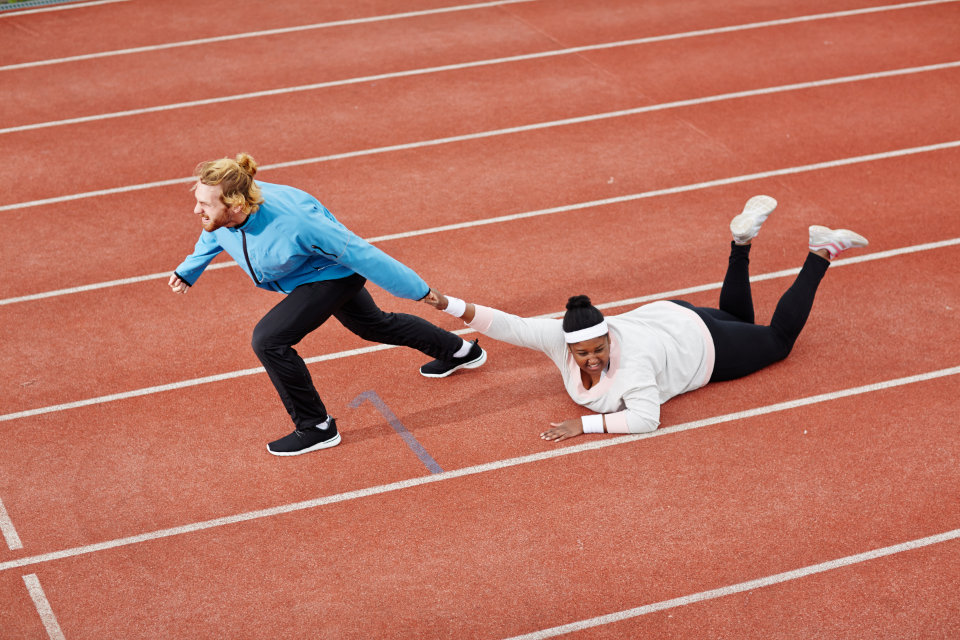Planning the next heavy deadlift session is not necessarily a very common discussion topic among endurance athletes.
Going to the gym to move some weight is often just an afterthought of endurance athletes and is seen as something to do perhaps for injury prevention or maybe if the weather is bad.
Some endurance athletes fear that spending too much, or any for that matter, time in the gym will result in a decrease in performance. However, what if I told you that NOT lifting could be preventing you from seeing progress in your training.
Weightlifting, when done appropriately, will not only not hurt your performance but can actually improve endurance performance.
Next, what if I told you that if you do go to the gym, you’d be better off using a program similar to a power-lifter rather than a bodybuilder?
We’re talking about lifting some heavy weight.
Heavy-Lifting Works
A study by Aagard & Anderson (2010) looked at the effect that concurrent training (endurance training and strength training done simultaneously) had on the endurance performance of top-level endurance athletes.
At the end of their study, Aagard & Anderson concluded that strength training can lead to endurance improvements in both short-term endurance (<15 minutes) and long-term endurance (>30 minutes noting that this was accomplished “especially with the use of high‐volume, heavy‐resistance strength training protocols.”
Now, when we talk about “heavy” training in the strength and conditioning world we are talking about “heavy” relative to the person.
This is generally seen as working with weight >85% of a 1RM with a 1-5 rep scheme.
Don’t worry about the above quote saying “>30 minutes” as many of you perform much longer than 30 minutes. Put the emphasis on “>” not “30 minutes”.
For example, one interesting study which Aagard & Anderson (2010) noted was a recent study conducted with well-trained cyclists who either performed endurance training alone or endurance training with strength training.
It was concluded that the cycling economy of high-level cyclists was improved to a greater extent by the group which included strength training than the group which only trained endurance alone.
In the study, they found that in the final hour of a 185-min long cycling test, the strength group experienced a reduced rise in heart rate and lower blood lactate levels.
A lower heart rate with lower blood lactate indicates the cyclists are able to push harder and longer.
It is important to note that this was in “trained” cyclists which is when we note harder progression than in a beginner.

I Get Asked Quite Often
At my training center I’m the endurance guy so when clients are interested in training for endurance, they come to me.
They often come to me thinking we are going to do some high reps or some sort of circuit training and are surprised when I tell them “Nope; We’re lifting heavy.”
This is often the opposite of what endurance athletes expect to do when going to the gym but let’s step back and look logically at what we are doing.
When we go to the gym as endurance athletes, we want to strengthen the muscle; we are not trying to replicate our cycling or running.
How many steps do you take in a marathon or revolutions do you crank out when cycling a 150km ride? Thousands and thousands.
Obviously, there is no way we are going to replicate the muscular endurance required on the road with endurance training in the gym unless you want to spend all day knocking out thousands of squats (I pray for your knees).
However, what we can do is make your muscle stronger and more efficient by lifting heavy which will cause several adaptations to occur.
What Happens When We Lift Heavy
The first thing that lifting heavy will improve is the quality of muscle we have by increasing the neuromuscular efficiency (NE) of it.
Basically, when we increase our NE, we are effectively taking the muscle we have and having it function better. Increased NE works mainly by recruiting more and larger muscle fibers faster as well as increase the rate of coding.
What this means is that the muscle that you have is able to work better, create more force, and be more efficient in all around function. Increasing NE is important for endurance athletes because a muscular system with higher NE results in better “economy” and “cardiovascular function” (Beattie et. al, 2014).
This is backed by a research study from Bonnacci, Chapman, Blanch, & Vicenzino(2009) which looked at the relationship between an increase in neuromuscular adaptations (NA) and training in endurance sports concluding “It had previously been assumed that superior cycling and running performance was evidence for greater neuromuscular adaptation in trained athletes. Recent scientific knowledge supports this belief”.
When a muscle is more efficient, it is capable of creating more force with less energy which translates to a higher work economy and endurance.
This is similar to what happens when we first start running and our form is awkward and out of line.
Due to this, we waste a lot of energy merely because our body is not functioning as efficient as it could. However, through practice, our running form improves and less effort is needed to run. Improved neuromuscular efficiency equals improved performance.
Our work economy will also improve as a result of lifting heavy due to an increase in the rate of force development (RFD).
In a study examining the effects that maximal strength training (MST), which is described with working with weights equal to 4-5RM, and conventional strength training (CST), which is described with working with weights equal to 10RM in sets of 3, has on WE, it was concluded that MST results in greater work economy “likely due to increase in strength (1RM) and RFD”. (Heggelund, Himland, Helgeurd, & Hoff, 2013).
The importance of RFD is also noted by Beattie et. al, (2009) research; “Endurance-specific muscle power is the ability of the neuromuscular system to rapidly produce force following a sustained period of high-intensity exercise…
Therefore, rate of force development (RFD) is essential not only in sprint and power sports, but also in elite endurance competition”.
By lifting in the 3-5 rep range, we increase our bodies ability to generate force which is generated through greater strength.

What Does All This Mean?
As an endurance athlete, you should not neglect going to the gym. You don’t need to make it overly complicated as working with simple, multi-compound movements using heavy weights will elicit the greatest improvement in your neuromuscular efficiency as well as producing the highest force production (Heggelund, Himland, Helgeurd, & Hoff, 2013).
These are the staple movements which would include; squats, deadlifts, leg press, cleans, etc. while using >85% of your 1RM.
It’s up to the athlete and their goals to decide how many hours they want to spend in the gym based on their individual goals, time restraints, etc but for a very race-centric athlete, I see no reason for more than 2 1-hour sessions and I actually think 1 1-hour session a week would be suffice.
Regardless, don’t be afraid to step in the gym and lift some weight; there’s a much better chance it will help your performance rather than harm it.
How often do you lift? Let us know in the comments below.





